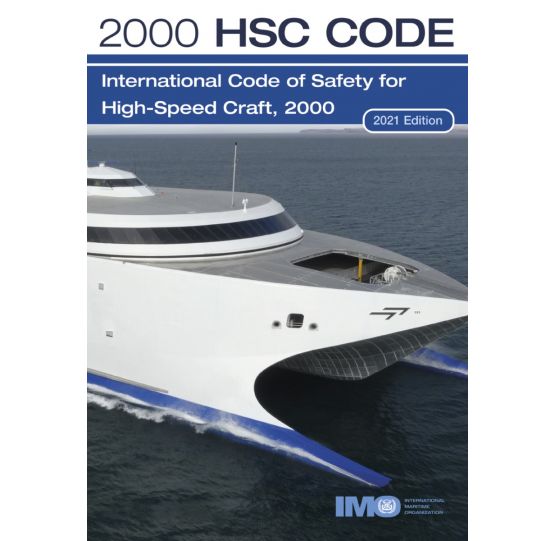High Speed Craft (2000 HSC) Code, 2021 Edition
S$82.06
March 2021
The Maritime Safety Committee adopted, in December 2000 by resolution MSC.97(73), the International Code of Safety for High-Speed Craft, 2000 (2000 HSC Code), which was made mandatory under chapter X (Safety measures for high-speed craft) of the 1974 SOLAS Convention and applies to high-speed craft engaged on international voyages the keels of which are laid or which were at a similar stage of construction on or after 1 July 2002.
In stock
This 2021 edition of the 2000 HSC Code contains consolidated text that incorporates the amendments adopted by the Maritime Safety Committee by resolutions MSC.175(79), MSC.222(82), MSC.260(84), MSC.271(85), MSC.326(90), MSC.352(92), MSC.424(98) and MSC.439(99).
Foreword
The International Code of Safety for High-Speed Craft, 2000 (2000 HSC Code) provides a comprehensive set of requirements, including those for the design and construction of high-speed craft engaged on international voyages, the equipment that shall be provided and the conditions for their operation and maintenance.
The aim of the Code is to set levels of safety that are equivalent to those of conventional ships required by the International Convention for the Safety of Life at Sea, 1974, as amended, (SOLAS Convention) and the International Convention on Load Lines, 1966 (Load Line Convention) by the application of constructional and equipment standards in conjunction with strict operational controls.
A high-speed craft is of a light displacement compared with a conventional ship and the displacement aspect is the essential parameter to obtaining fast and competitive sea transportation. This Code allows for the use of non-conventional shipbuilding materials for light displacement, provided that a safety standard at least equivalent to conventional ships is achieved.
The Code requirements also reflect the additional hazards associated with high-speed craft as compared with conventional ship transportation, such as collision at high speed, the consequences of which are mitigated by more stringent navigational and operational requirements and specially developed accommodation provisions.
The 2000 HSC Code was adopted by the Maritime Safety Committee at its seventy-third session (27 November to 6 December 2000), by resolution MSC.97(73), following a revision of the International Code of Safety for High-Speed Craft, 1994 (1994 HSC Code) (resolution MSC.36(63)), which in turn had been developed following a revision of the Code of Safety for Dynamically Supported Craft (DSC Code) (resolution A.373(X)).
The 1994 and the 2000 HSC Codes are mandatory under chapter X (Safety measures for high-speed craft) of the 1974 SOLAS Convention and apply to high-speed craft engaged on international voyages the keels of which are laid or which were at a similar stage of construction on or after 1 January 1996 (1994 HSC Code) and on or after 1 July 2002 (2000 HSC Code), respectively. For high-speed craft constructed before 1 January 1996, the DSC Code should be applied.
Since then, amendments to the 2000 HSC Code have been adopted by the Maritime Safety Committee by resolutions MSC.175(79), MSC.222(82), MSC.260(84), MSC.271(85), MSC.326(90), MSC.352(92), MSC.424(98) and MSC.439(99), following the provisions of section 1.15 of the Code for a regular review of the existing requirements to take account of new developments in design and technology.
The present 2021 edition contains the consolidated text of the 2000 HSC Code, incorporating the amendments adopted by the aforementioned resolutions, which entered into force and apply to high?speed craft engaged on international voyages. It also includes Unified Interpretations to 2000 HSC Code regulations, the Guidelines for uniform operating limitations of high-speed craft (MSC.1/Circ.1329) and SOLAS chapter X.


